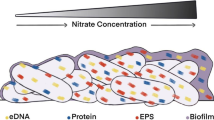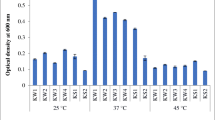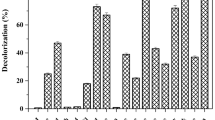Abstract
Free-living planktonic single bacterial strain can decolorize Congo red (CR) but often produces the carcinogenic, mutagenic and genotoxic aromatic amines. Planktonic single and bacterial consortia are more susceptible to toxic pollutants than their biofilm counterparts. In the present study, four biofilm consortia (C1 = Vitreoscilla sp. ENSG301, Acinetobacter lwoffii ENSG302, Klebsiella pneumoniae ENSG303 and Pseudomonas fluorescens ENSG304, C2 = Escherichia coli ENSD101, Enterobacter asburiae ENSD102 and E. ludwigii ENSH201, C3 = E. asburiae ENSD102, Vitreoscilla sp. ENSG301 and Bacillus thuringiensis ENSW401, and C4 = E. coli ENSD101, E. ludwigii ENSH201 and B. thuringiensis ENSW401) were prepared and assessed for bioremediation of CR. All these biofilm consortia remarkably decolorized (96.9 to 99.5%) the CR (100 mg/L) in static condition within 72 h incubation at 28 °C. These consortia also synthesized significantly more intracellular azoreductase and laccase enzyme than extracellular of these enzymes. UV–Vis spectral analysis revealed that the major peak at 478 nm wavelength of CR was completely disappeared. FTIR analysis showed several major peaks along with azo bonds are completely or partly disappeared, deformed or widened. Chemical oxygen demand was reduced by 86.4, 85.5, 87.0 and 86.2% by C1, C2, C3 and C4, respectively. Accordingly, biodegraded metabolites of CR by different biofilm consortia did not inhibit the germination of wheat seeds and bacterial growth. Thus, these biofilm consortia can be applied in bioremediation of wastewater containing CR for safe disposal into the environment. To our knowledge, this is the first report on degradation and detoxification of aqueous solution containing CR by bacterial biofilm consortia.




Similar content being viewed by others
References
Abo-State MAM, Saleh YE, Hazaa HA (2017) Decolorization of Congo red dye by bacterial isolates. J Eco Heal Env 5(2):41–48. https://doi.org/10.12785/jehe/050201
Ahmad A, Mohd-Setapar SH, Chuong CS, Khatoon A, Wani WA, Kumar R, Rafatullah M (2015) Recent advances in new generation dye removal technologies: novel search for approaches to reprocess wastewater. RSC Adv 5(39):30801–30818. https://doi.org/10.1039/c4ra16959j
Anjaneyulu Y, Chary NS, Raj SSD (2005) Decolorization of industrial effluents-available methods and emerging technologies-a review. Rev Environ Sci Biotech 4(4):245–273. https://doi.org/10.1007/s11157-005-1246-z
APHA (2012) Standard methods for the examination of water and wastewater, 20th edn. American public Health Association, Washington, DC, USA
Asad S, Amoozegar MA, Pourbabaee AA, Sarbolouki MN, Dastgheib SM (2007) Decolorization of textile dyes by newly isolated halophilic and halotolerant bacteria. Bioresour Technol 98(11):2082–2088. https://doi.org/10.1016/j.biortech.2006.08.020
Asses N, Ayed L, Hkiri N, Hamdi M (2018) Congo red decolorization and detoxification by Aspergillus niger: removal mechanisms and dye degradation pathway. BioMed Res Int. https://doi.org/10.1155/2018/3049686
Ayati A, Shahrak MN, Tanhaei B, Sillanpaa M (2016) Emerging adsorptive removal of azo dye by metal-organic frameworks. Chemosphere 160:30–44. https://doi.org/10.1016/j.chemosphere.2016.06.065
Babu SS, Mohandass C, Vijayaraj AS, Dhale MA (2015) Detoxification and color removal of Congo red by a novel Dietzia sp. (DTS26) - A microcosm approach. Ecotoxicol Environ Safety 114:52–60. https://doi.org/10.1016/j.ecoenv.2015.01.002
Balapure K, Bhatt N, Madamwar D (2014) Mineralization of reactive azo dyes present in stimulated textile wastewater using down flow microaerophilic fixed film bioreactor. Bioresour Technol 175:1–7. https://doi.org/10.1016/j.biortech.2014.10.040
Bhatia D, Sharma NR, Singh J, Kanwar RS (2017) Biological methods for textile dye removal wastewater: a review. Crit Rev Environ Sci Technol 47(19):1836–1876. https://doi.org/10.1080/10643389.2017.1393263
Bhattacharya S, Das A, Mangai G, Vignesh K, Sangeetha J (2011) Mycoremediation of Congo red by filamentous fungi. Brazilian J Microbiol 42(4):1526–1536. https://doi.org/10.1590/S1517-83822011000400040
Chakraborty S, Basak B, Dutta S, Bhunia B, Dey A (2013) Decolorization and biodegradation of Congo red dye by a novel white rot fungus Alternaria alternata CMERI F6. Bioresour Technol 147:662–666. https://doi.org/10.1016/j.biortech.2013.08.117
Chang JS, Chou C, Lin Y, Ho J, Hu TL (2001) Kinetic characteristics of bacterial azo dye decolorization by Pseudomonas lutola. Water Res 35(12):2041–2050. https://doi.org/10.1016/S0043-1354(00)00581-9
Chang JS, Kuo TS, Chao YP, Ho JY, Lin PJ (2000) Azo dye decolorization with a mutant Escherichia coli strain. Biotechnol Lett 22:807–812. https://doi.org/10.1023/A:1005624707777
Chen H, Hopper SL, Cerniglia CE (2005) Biochemical and molecular characterization of an azoreductase from Staphylococcus aereus, a tetrameric NADPH-dependent flavoprotein. Microbiol 151(5):1433–1441. https://doi.org/10.1099/mic.0.27805-0
Chen KC, Wu JY, Liou DJ, Hwang SCJ (2003) Decolorization of the textile dyes by newly isolated bacterial strains. J Biotechnol 101(1):57–68. https://doi.org/10.1016/S0168-1656(02)00303-6
Chengalroyen MD, Dabbs ER (2013) The microbial degradation of azo dyes: minireview. World J Microbiol Biotechnol 29(3):389–399. https://doi.org/10.1007/s11274-012-1198-8
Chung KT, Stevens SEJ, Cerniglia CE (1992) The reduction of azo dyes by the intestinal microflora. Crit Rev Microbiol 18(3):175–197. https://doi.org/10.3109/10408419209114557
Edwards SJ, Kjellerup BK (2013) Application of biofilms in bioremediation and biotransformation of persistent organic pollutants, pharmaceuticals/personal care products, and heavy metals. Appl Microbiol Biotechnol 97:9909–9921. https://doi.org/10.1007/s00253-013-5216-z
Forgacs E, Cserhati T, Oros G (2004) Removal of synthetic dyes from wastewater: a review. Environ Intl 30(7):953–971. https://doi.org/10.1016/j.envint.2004.02.001
Furuya N, Yamasaki S, Nishioka M, Shirasshi I, Ityama K, Matsuyama N (1997) Antibacterial activities of pseudomonads against plantpathogenic organisms and efficacy of Pseudomonas aeruginosa ATCC7700 against bacterial wilt of tomato. Ann Phytopathol Soc Jpn 63(6):417–424. https://doi.org/10.3186/jjphytopath.63.417
Ghodake G, Jadhav S, Dawkar V, Govindar SP (2009) Biodegrdation of diazo dye direct brown MR by Acinetobacter calcoaceticus NCIM 2890. Int Biodeter Biodegr 63(4):433–439. https://doi.org/10.1016/j.ibiod.2008.12.002
Gopinath KP, Murugenesan S, Abraham J, Muthukumar K (2009) Bacillus sp. mutant for improved biodegradation of Congo red: random mutagenesis approach. Bioresour Technol 100(24):6295–6300. https://doi.org/10.1016/j.biortech.2009.07.043
Haque MM, Oliver MMH, Nahar K, Alam MZ, Hirata H, Tsuyumu S (2017) CytR homolog of Pectobacterium carotovorum subsp. carotovorum controls air-liquid biofilm formation by regulating multiple genes involved in cellulose production, c-di-GMP signaling, motility, and type III secretion system in response to nutritional and environmental signals. Front Microbiol 8:972. https://doi.org/10.3389/fmicb.2017.00972
Haque MM, Hirata H, Tsuyumu S (2012) Role of PhoP-PhoQ two-component system in pellicle formation, virulence and survival in harsh environments of Dickeya dadantii 3937. J Gen Plant Pathol 78(3):176–189. https://doi.org/10.1007/s10327-012-0372-z
He H, Chen Y, Li X, Cheng Y, Yang C, Zeng G (2017) Influence of salinity on microorganisms in activated sludge processes: a review. Int Biodeter Biodegr 119:520–527. https://doi.org/10.1016/j.ibiod.2016.10.007
Huang X, Bo X, Zhao Y, Gao B, Wang Y, Sun S, Yue Q, Li Q (2014) Effects of compound bioflocculant on coagulation performance and floc properties for dye removal. Bioresour Technol 165:116–121. https://doi.org/10.1016/j.biortech.2014.02.125
Imran M, Crowley DE, Khalid A, Hussain S, Mumtaz MW, Arshad M (2014) Microbial biotechnology for decolorization of textile wastewaters. Rev Environ Sci Biotechnol 14(1):73–92. https://doi.org/10.1007/s11157-014-9344-4
Jadav JP, Parshetti GK, Kalme SD, Govindwar SP (2007) Decolorization of dye Methyl red by Saccharomyces cerevisiae MTCC463. Chemosphere 68(2):394–400. https://doi.org/10.1016/j.chemosphere.2006.12.087
Jadhav SU, Jadhav MU, Kagalkar AN, Govindwar SP (2008) Decolorization of Brilliant Blue G dye mediated by degradation of the microbial consortium of Galactomyces geotrichum and Bacillus sp. J Chin Inst Chem Eng 39(6):563–570. https://doi.org/10.1016/j.jcice.2008.06.003
Jafaria N, Soudib MR, Kermanshahi RK (2014) Biodegradation perspectives of azo dyes by yeasts. Microbiol 83:484–497. https://doi.org/10.1134/S0026261714050130
Joshi T, Iyengar L, Singh K, Garg S (2008) Isolation, identification and application of novel bacterial consortium TJ-1 for decolorization of structurally different azo dyes. Bioresour Technol 99(15):7115–7121. https://doi.org/10.1016/j.biortech.2007.12.074
Kilic NK, Nielsen JL, Yuce M, Donmez G (2007) Characterization of a simple bacterial consortium for effective treatment of wastewaters with reactive dyes and Cr(VI). Chemosphere 67(4):826–831. https://doi.org/10.1016/j.chemosphere.2006.08.041
Kodam KM, Soojhawon I, Lokhande PD, Gawal KR (2005) Microbial decolorization of reactive azo dyes under aerobic conditions. World J Microbial Biotechnol 21:367–370. https://doi.org/10.1007/s11274-004-5957-z
Koechler S, Farasin J, Cleiss-Arnold J, Arséne-Ploetze F (2015) Toxic metal resistance in biofilms diversity of microbial responses and their evolution. Res Microbiol 166(10):764–773. https://doi.org/10.1016/j.resmic.2015.03.008
Kuhad RC, Sood N, Tripathi KK, Singh A, Ward OP (2004) Developments in microbial methods for the treatment of dye effluents. Adv Appl Microbiol 56:185–213. https://doi.org/10.1016/S0065-2164(04)56006-9
Kuppusamy S, Sethurajan M, Kadaekarai M, Aruliah R (2017) Biodecolourization of textile dyes by novel, indigenous Pseudomonas stutzeri MN1 and Acinetrobacter baumannii MN3. J Environ Chem Engineer 5:716–724. https://doi.org/10.1016/j.jece.2016.12.021
Kumar A, Sharma SK, Sharma G, Al-Muhtaseb AAH, Naushad M, Ghfar AA, Stadler FJ (2019) Wide spectral degradation of Norfloxacin by Ag@BiPO4/BiOBr/BiFeO3 nano-assembly: elucidating the photocatalytic mechanism under different light sources. J Hazard Mat 364:429–440. https://doi.org/10.1016/j.jhazmat.2018.10.060
Lade H, Govindwar S, Paul D (2015a) Mineralization and detoxification of the carcinogenic azo dye Congo red and real textile effluent by a polyurethane foam immobilized microbial consortium in an upflow column bioreactor. Int J Environ Res Public Health 12(6):6894–6918. https://doi.org/10.3390/ijerph120606894
Lade H, Kadam A, Paul D, Govindwar SP (2015b) A low-cost wheat bran medium for biodegradation of the benzidine-based carcinogenic dye Trypan blue using a microbial consortium. Int J Environ Res Public Health 12(4):3480–3505. https://doi.org/10.3390/ijerph120403480
Lee YC, Jang MS, Cho YS, Cha IH, Choi YL, Kim CH (2005) Decolorization of a sulfonated azo dye, Congo Red, by Staphylococcus sp EY-3. J Microbiol Biotechnol 15(1):221–225
Lowry OH, Rosebrough NJ, Farr AL, Randall RJ (1951) Protein measurement with the Folin phenol reagent. J Biol Chem 193:265–275
McDougald D, Rice SA, Barraud N, Steinberg PD, Kjelleberg S (2012) Should we stay or should we go: mechanisms and ecological consequences for biofilm dispersal. Nat Rev Microbiol 10:39–50. https://doi.org/10.1038/nrmicro2695
Mosharaf MK, Tanvir MZH, Haque MM, Haque MA, Khan MAA, Molla AH, Alam MZ, Islam MS, Talukder MR (2018) Metal-adapted bacteria isolated from wastewaters produce biofilms by expressing proteinaceous curli fimbriae and cellulose nanofibers. Front Microbiol 9:1334. https://doi.org/10.3389/fmicb.2018.01334
Olukanni OD, Osuntoki AA, Awotula AO, Kalyani DC, Gbenle GO, Govindwar SP (2013) Decolorization of dyehouse effluent and biodegradation of Congo red by Bacillus thuringiensis RUN1. J Microbiol Biotechnol 23(6):843–849. https://doi.org/10.4014/jmb.1211.11077
Pandey A, Singh P, Iyengar L (2007) Bacterial decolorization and degradation of azo dyes. Int Biodeter Biodegr 59(2):73–84. https://doi.org/10.1016/j.ibiod.2006.08.006
Phugare SS, Kalyani DC, Surwase SN, Jadhav JP (2011) Eco-friendly degradation, decolorization and detoxification of textile effluent by a developed bacterial consortium. Ecotoxicol Environ Safe 74(5):1288–1296. https://doi.org/10.1016/j.ecoenv.2011.03.003
Prasad SS, Aikat K (2014) Study of bio-degradation and bio-decolorization of azo dye by Enterobacter sp. SXCR Environ Technol 35(8):956–965. https://doi.org/10.1080/09593330.2013.856957
Rai H, Bhattacharya M, Singh J, Bansal TK, Vats P, Banerjee UC (2005) Removal of dyes from the effluent of textile and dyestuff manufacturing industry: A Review of emerging techniques with reference to biological treatment. Crit Rev Environ Sci Technol 35(3):219–238. https://doi.org/10.1080/10643380590917932
Robinson T, McMullan G, Marchant R, Nigam P (2001) Remediation of dyes in textile effluent: a critical review on current treatment technologies with a proposed alternative. Bioresour Technol 77(3):247–255. https://doi.org/10.1016/S0960-8524(00)00080-8
Saratale RG, Saratale GD, Chang JS, Govindwar SP (2011) Bacterial decolorization and degradation of azo dyes: a review. J Taiwan Inst Chem Engineer 42(1):138–157. https://doi.org/10.1016/j.jtice.2010.06.006
Saratale RG, Saratale GD, Chang JS, Govindwar SP (2009a) Eco-friendly decolorization and degradation of sulfonated diazo dye C.I. Reactive Green 19A using Micrococcus glutamicus NCIM-2168. Bioresour Technol 110(17):3897–3905. https://doi.org/10.1016/j.biortech.2009.03.051
Saratale RG, Saratale GD, Kalyani DC, Chang JS, Govindwar SP (2009b) Enhanced decolorization and biodegradation of textile azo dye Scarlet R by using developed microbial consortium-GR. Bioresour Technol 100(9):2493–2500. https://doi.org/10.1016/j.biortech.2008.12.013
Sarim KM, Kukreja K, Shah I, Choudhary CK (2019) Biosorption of direct textile dye Congo red by Bacillus subtilis HAU-KK01. Bioremediation J 23(3):185–195. https://doi.org/10.1080/10889868.2019.1641466
Sarkar S, Banerjee A, Halder U, Biswas R, Bandopadhyay R (2017) Degradation of synthetic azo dyes of textile industry: a sustainable approach using microbial enzymes. Water Conserv Sci Eng 2:121–131. https://doi.org/10.1007/s41101-017-0031-5
Sathish S, Joshua A (2015) Study on decolorization of dye stuff (azo dye–Congo red) by using bacterial consortia. Int J Pharm Pharm Sci 7:143–146
Sathishkumar K, Alsalhi MS, Sanganyado E, Devanesan S, Arulprakash A, Rajasekar A (2019) Sequential electrochemical oxidation and bio-treatment of the azo dye congo red and textile effluent. J Photochem Photobiol B Biol 200:111655. https://doi.org/10.1016/j.jphotobiol.2019.111655
Selvakumar S, Manivasagan R, Chinnappan K (2013) Biodegradation and decolourization of textile dye wastewater using Ganoderma lucidum. 3 Biotech. 3:71–79. https://doi.org/10.1007/s13205-012-0073-5
Telke AA, Kadam A, Govindwar SP (2015) Bacterial enzymes and their role in decolorization of azo dyes. In: Singh SN (ed.) Microbial degradation of synthetic dyes in wastewater, Environmental Science and Engineering, Springer, Cham, Switzerland, pp 149–168 https://doi.org/10.1007/978-3-319-10942-8_7
Telke AA, Joshi SM, Jadhav SU, Tamboli DP, Govindwar SP (2010) Decolorization and detoxification of Congo red and textile industry effluent by an isolated bacterium Pseudomonas sp. SU-EBT Biodegrad 21(2):283–296. https://doi.org/10.1007/s10532-009-9300-0
Telke AA, Kalyani DC, Dawkar VV, Govindwar SP (2009) Influence of organic and inorganic compounds on oxidoreductive decolorization of sulfonated azo dye C. I. Reactive orange 16. J Hazard Mater 172(1):298–309. https://doi.org/10.1016/j.jhazmat.2009.07.008
Vikrant K, Giria BS, Razab N, Roya K, Kimd KH, Raia BN, Singha RS (2018) Recent advancements in bioremediation of dye: Current status and challenges. Bioresour Technol 253:355–367. https://doi.org/10.1016/j.biortech.2018.01.029
Wang N, Chu Y, Wu F, Zhao Z, Xu X (2017) Decolorization and degradation of Congo red by a newly isolated white rot fungus, Ceriporia lacerata from decayed mulberry branches. Int Biodeter Biodegr 117:236–244. https://doi.org/10.1016/j.ibiod.2016.12.015
Willmott NJ (1997) The use of bacteria polymer composites for the removal of color from reactive dye effluents. PhD thesis, University of Leeds, UK
Wolfenden BS, Willson RL (1982) Radical-cations as reference chromogens in kinetic studies of ono-electron transfer reactions: pulse radiolysis studies of 2,2ʹ-azinobis-(3-ethylbenzthiazoline-6 sulphonate). J Chem Soc Perkin Trans 2(7):805–812. https://doi.org/10.1039/P29820000805
Acknowledgements
This research is funded by the Ministry of Education (Project ID: LS2018751) and Ministry of Science and Technology of Bangladesh. No funds received form any organizations for the publication.
Author information
Authors and Affiliations
Contributions
MMH conceived the idea, developed all the methodologies, conducted several experiments, wrote the MS and collected the research fund. MAH helped in planning the research, conducted the FTIR spectroscopy and edited the MS. MKM conducted the compatibility tests. PKM conducted the CR decolorization assays. All the authors read the MS.
Corresponding author
Ethics declarations
Conflicts of interest
The authors declare that the research was conducted in the absence of any commercial or financial relationships that could be construed as a potential conflict of interest.
Additional information
Communicated by Erko stackebrandt.
Publisher's Note
Springer Nature remains neutral with regard to jurisdictional claims in published maps and institutional affiliations.
Rights and permissions
About this article
Cite this article
Haque, M.M., Haque, M.A., Mosharaf, M.K. et al. Novel bacterial biofilm consortia that degrade and detoxify the carcinogenic diazo dye Congo red. Arch Microbiol 203, 643–654 (2021). https://doi.org/10.1007/s00203-020-02044-1
Received:
Revised:
Accepted:
Published:
Issue Date:
DOI: https://doi.org/10.1007/s00203-020-02044-1




